Handball is one of the most dynamic and fast-paced team sports in the world. Combining the agility of basketball, the strategy of soccer, and the intensity of hockey, it offers a thrilling mix of athleticism and teamwork. Although handball may not yet enjoy the same global fame as football or basketball, its popularity is rapidly increasing, especially in Europe, Asia, and South America. In this article, we explore the origins, rules, gameplay, and global appeal of handball — a sport that truly embodies speed, power, and precision 99ok.
What Is Handball?
Handball is a high-intensity team sport played indoors, where two teams of seven players (six field players and one goalkeeper) compete to score by throwing the ball into the opponent’s goal. The objective is simple — outscore the other team within two 30-minute halves. Yet, the gameplay is incredibly complex, requiring coordination, lightning-fast passes, and tactical decision-making.
The court measures 40 by 20 meters, featuring a goal area around each net. Players advance the ball by passing, dribbling, or running, but they can only take up to three steps without dribbling and hold the ball for a maximum of three seconds. These quick transitions make handball one of the most exciting sports to watch and play.
The Origins and Evolution of Handball
Modern handball traces its roots to Europe, particularly Denmark, Germany, and Sweden, where various ball games using hands were popular in the late 19th century. The first official rules were codified in Denmark in 1906 by Holger Nielsen. By the 1920s, the sport began to take shape as team handball, played outdoors with 11 players per side.
The indoor version we know today emerged in the 1940s, making it suitable for year-round competition. Handball made its Olympic debut in 1936 for men (Berlin Games), and after a brief hiatus, returned permanently in 1972. Women’s handball joined the Olympics in 1976, solidifying the sport’s place on the world stage.
Today, the International Handball Federation (IHF), founded in 1946, governs the sport globally, with more than 200 member nations and millions of registered players.
Rules and Gameplay Explained
Understanding handball’s rules enhances appreciation for its strategy and intensity. A match consists of two halves of 30 minutes each, separated by a 10-minute halftime. Each team fields six outfield players and one goalkeeper. The main goal is to score by throwing the ball past the opposing goalkeeper from outside the goal area line (6-meter line).
Players can:
-
Dribble the ball continuously, similar to basketball.
-
Take up to three steps while holding the ball.
-
Hold the ball for a maximum of three seconds without moving.
Physical contact is allowed but controlled — defenders can block or hold opponents using their arms or body, but reckless tackling or striking is penalized. Fouls result in free throws or 7-meter penalties depending on severity.
Goalkeepers play a crucial role in defending their area, using any part of their body to stop shots. Due to the high speed of the ball — often exceeding 100 km/h — goalkeeping in handball requires extraordinary reflexes and courage.
Key Skills and Techniques
Success in handball depends on mastering several fundamental skills:
-
Passing and Ball Control – Quick, precise passes are essential to outmaneuver defenders.
-
Shooting Accuracy – Players must vary their shooting techniques, including jump shots, spin shots, and lob shots.
-
Defensive Positioning – Reading opponents’ movements and anticipating passes help prevent scoring opportunities.
-
Team Coordination – Fluid communication and movement are vital for executing offensive plays.
-
Endurance and Speed – With constant running, sprinting, and contact, handball demands exceptional physical fitness.
Top players, such as Mikkel Hansen (Denmark) and Cristina Neagu (Romania), are admired for their skill, vision, and leadership, inspiring a new generation of athletes.
Handball Around the World
Handball enjoys immense popularity across Europe, particularly in countries like France, Denmark, Germany, Spain, and Norway. These nations consistently dominate international tournaments, including the IHF World Championships and Olympic Games. France, in particular, has produced legendary teams and athletes, elevating handball’s profile worldwide.
In recent years, the sport has gained traction in Asia, Africa, and the Americas. Nations such as Egypt, Brazil, and Japan have developed competitive programs and invested in youth training systems. The International Handball Federation’s global initiatives continue to promote the sport in new regions, making it one of the fastest-growing indoor sports 99ok.com.
Major Competitions and Tournaments
The IHF World Men’s and Women’s Championships are the most prestigious international events, held every two years. Continental tournaments such as the EHF European Championship, Pan American Games, and Asian Handball Championship also attract huge audiences.
At the Olympic Games, handball stands out for its energy and unpredictability. Every match delivers spectacular goals, thrilling saves, and tactical brilliance. Club-level competitions like the EHF Champions League showcase elite talent and foster rivalries between top European clubs such as Paris Saint-Germain, FC Barcelona, and THW Kiel.
Handball’s Rising Popularity and Modern Appeal
Handball’s global appeal is fueled by its accessibility and entertainment value. It’s fast, simple to learn, and requires minimal equipment — just a ball, a goal, and a few enthusiastic players. The sport’s fast pace and continuous scoring make it ideal for television and online streaming audiences.
Additionally, handball’s integration with digital platforms, social media, and live analytics has made it more engaging than ever. From youth academies to professional leagues, handball is becoming a symbol of teamwork, sportsmanship, and determination.
Why You Should Try Handball
Whether you’re an athlete looking for a challenge or simply seeking an enjoyable way to stay fit, handball offers countless benefits. It improves cardiovascular health, strengthens muscles, enhances coordination, and boosts mental focus. More importantly, it fosters a sense of community — every player contributes to the team’s success.
Schools and clubs around the world now include handball in their sports programs, helping young players build confidence and discipline. The sport teaches valuable life skills such as teamwork, communication, and quick problem-solving.
Conclusion
Handball is more than just a game; it’s a celebration of human strength, agility, and collaboration. From its European origins to its modern global reach, the sport continues to inspire players and fans with its speed, creativity, and excitement. As international interest grows and new talents emerge, handball’s future looks brighter than ever.
Whether played competitively or recreationally, handball remains one of the most captivating sports — a perfect blend of physical challenge and strategic brilliance.

